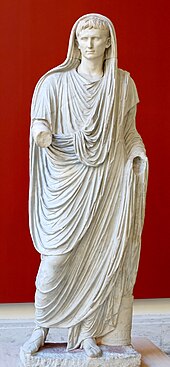
Back الحبر الأعظم Arabic Baş pontifik Azerbaijani Вялікі пантыфік Byelorussian Вялікі пантыфік BE-X-OLD Понтифекс максимус Bulgarian Pontífex màxim Catalan Pontifex maximus Czech Pontifex maximus Danish Pontifex maximus German Pontifex Maximus Greek

The pontifex maximus (Latin for "supreme pontiff"[1][2][3]) was the chief high priest of the College of Pontiffs (Collegium Pontificum) in ancient Rome. This was the most important position in the ancient Roman religion, open only to patricians until 254 BC, when a plebeian first held this position. Although in fact the most powerful office in the Roman priesthood, the pontifex maximus was officially ranked fifth in the ranking of the highest Roman priests (Ordo Sacerdotum), behind the Rex Sacrorum and the flamines maiores (Flamen Dialis, Flamen Martialis, Flamen Quirinalis).[4]
A distinctly religious office under the early Roman Republic, it gradually became politicized until, beginning with Augustus, it was subsumed into the position of emperor in the Roman imperial period. Subsequent emperors were styled pontifex maximus well into Late Antiquity, including Gratian (r. 367–383), but during Gratian's reign the phrase was replaced in imperial titulature with the Latin phrase: pontifex inclytus ("honourable pontiff"), an example followed by Gratian's junior co-emperor Theodosius the Great and which was used by emperors thereafter including the co-augusti Valentinian III (r. 425–455), Marcian (r. 450–457) and the augustus Anastasius Dicorus (r. 491–518). The first to adopt the inclytus alternative to maximus may have been the rebel augustus Magnus Maximus (r. 383–388).
The word pontifex and its derivative "pontiff" became terms used for Christian bishops,[5] including the Bishop of Rome.[6][7] The title of pontifex maximus was applied to the Roman Catholic Church for the pope as its chief bishop and appears on buildings, monuments and coins of popes of Renaissance and modern times. The official list of titles of the pope given in the Annuario Pontificio includes "supreme pontiff" (Latin: summus pontifex) as the fourth title, the first being "bishop of Rome".[8]
- ^ Peck, Harry Thurston (1896). "s. v. Pontifex". Harper's Dictionary of Classical Antiquities. New York: Harper & Brothers. p. 1299.
- ^ Lewis, Chartlon T.; Short, Charles (1879). "s. v. pontifex". A Latin Dictionary. Oxford: Clarendon Press – via Perseus Project.
- ^ "s. v. pontifex". American Heritage Dictionary (5th ed.). Houghton Mifflin Harcourt Publishing Company. 2019.
- ^ Forsythe, Gary (2006). A Critical History of Early Rome: From Prehistory to the First Punic War. University of California Press. p. 136. ISBN 978-0-520-24991-2. Retrieved September 2, 2016.
- ^ Pascal, Paul (February 1966). "Medieval Uses of Antiquity". The Classical Journal. 61 (5). The Classical Association of the Middle West and South, Inc.: 193–197. JSTOR 3294702.
In the matter of hierarchical nomenclature, one of the most striking instances is the adoption of the term pontifex for a bishop
- ^ Edictum Gratiani, Valentiani et Theodosii de fide catholica. The Roman Law Library. February 27, 380. Archived from the original on April 27, 2014. Retrieved January 6, 2018.
- ^ "Pontiff: 1a. The pope. b. A bishop. 2. A pontifex.". The American Heritage Dictionary of the English Language (4th ed.). Houghton Mifflin Harcourt Publishing Company. 2000. Retrieved June 27, 2019.
- ^ Annuario Pontificio. Libreria Editrice Vaticana. 2012. p. 23. ISBN 978-88-209-8722-0.